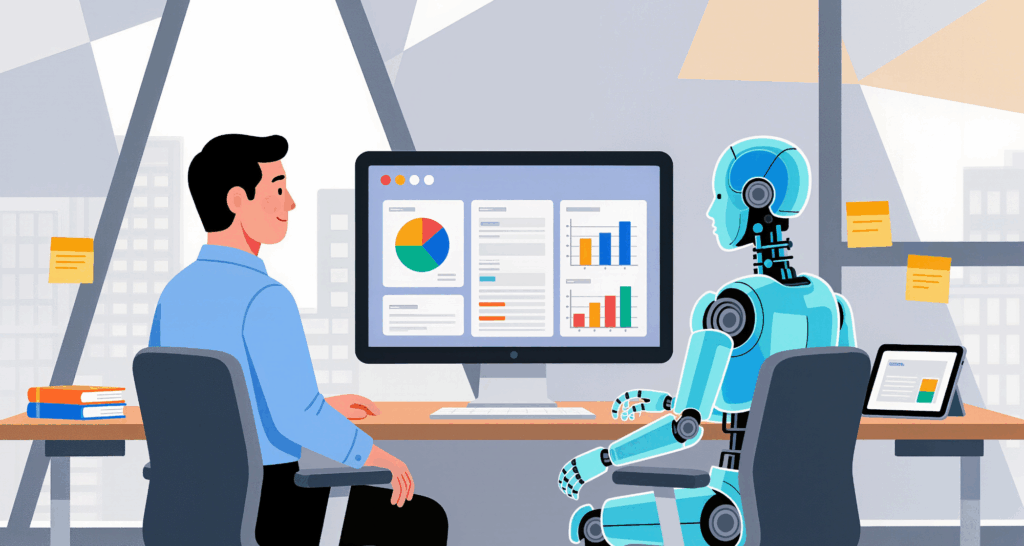The Human + AI Org: Designing Roles, Responsibilities, and RACI for Hybrid Teams
As AI agents become active collaborators in daily work, organizations must rethink how roles, responsibilities, and accountability are structured. This shift calls for a practical framework for hybrid human-AI teams. One that defines emerging roles, clarifies tasks using RACI, and outlines training and implementation strategies. The goal: build teams where humans and AI work together seamlessly, with trust, autonomy, and oversight.
Why Hybrid Teams Need a New Operating Model
AI agents are no longer background automation; they’re active teammates shaping decisions, generating content, and analyzing data. To unlock their potential, organizations must define how hybrid teams actually work. Without clear roles and accountability, collaboration breaks down.
Traditional organization charts weren’t built for intelligent systems that operate continuously, span multiple teams, and make autonomous recommendations. This mismatch creates friction and missed opportunities. AI agents defy assumptions about supervision, reporting lines, and decision loops. A single agent might simultaneously support customer service, analyze marketing data, and assist with financial forecasting.
Without clear ownership, valuable insights stall. Teams debate who’s responsible for AI-generated recommendations. Work gets duplicated or dropped. The solution isn’t tighter control or unchecked autonomy; it’s a new framework for collaboration.
Emerging Roles in Human-AI Organizations
To make hybrid teams work, new roles are emerging. Not just new titles, but new ways of organizing expertise and accountability.
- Prompt Engineer: Crafts natural language instructions that guide AI toward usable outputs. Balances technical fluency with business context to test, refine, and scale prompt libraries.
- AI Steward: Oversees governance, risk, and ethical alignment. Designs safeguards, monitors behavior, and intervenes when AI decisions deviate from policy or values.
- Human-in-Command: Retains final authority over critical decisions. Develops judgment about when to trust, override, or escalate AI recommendations.
- AI Operations Specialist: Maintains the infrastructure behind AI agents. Monitors performance, manages deployments, and troubleshoots unexpected behavior.
These roles evolve with scale. In smaller organizations, one person may wear multiple hats. In larger enterprises, dedicated teams emerge. Either way, these functions are essential to the success of hybrid teams.
Applying RACI to Hybrid Workflows
The RACI framework (Responsible, Accountable, Consulted, Informed) helps clarify who does what. In hybrid teams, AI agents can be responsible for execution, but accountability must always rest with humans.
Example: Social Media Workflow
- AI Agent: Responsible for drafting social media posts based on campaign briefs and brand voice.
- Content Strategist: Accountable for final messaging and alignment with business goals.
- Prompt Engineer: Consulted to improve prompt quality and output consistency.
- Marketing Director: Informed of publishing cadence and performance metrics.
This structure prevents confusion. The AI doesn’t publish directly; the strategist reviews. The prompt engineer isn’t responsible for tone, but they help refine it. The director stays informed without micromanaging.
For more complex workflows, a full RACI matrix helps map responsibilities across humans and AI agents. Here’s how it plays out in a customer support team:
Sample RACI Matrix: Customer Support Hybrid Team
Task | Responsible | Accountable | Consulted | Informed |
Customer Inquiry Intake | AI Agent (Chatbot) | Support Team Lead | AI Steward | Customer Success Manager |
Routine Issue Resolution | AI Agent | Support Representative | Technical Support | Support Manager |
Complex Problem Diagnosis | Support Representative + AI Agent | Support Team Lead | Product Team | Engineering |
Escalation Decision | AI Agent flags, Support Rep decides | Support Team Lead | Account Manager | Executive Team |
Customer Sentiment Analysis | AI Agent + AI Ops | Support Team Lead | Product Team | Marketing |
Knowledge Base Updates | AI Agent + Support Rep | Content Manager | Product Team | Support Staff |
This matrix makes several things clear:
- AI handles first-contact response, but humans remain accountable for customer satisfaction.
- Both AI and humans contribute to problem-solving, with clear divisions based on complexity.
- Escalation involves AI flagging and human judgment.
- AI provides analysis, but humans decide how to act on insights.
The Consulted and Informed roles prevent bottlenecks and ensure relevant teams stay looped in without unnecessary approvals. This is how hybrid teams maintain speed without sacrificing oversight.
Training Plan for Hybrid Team Success
Defining roles and workflows is only half the equation. For hybrid teams to succeed, people must be equipped to execute their responsibilities confidently and collaboratively. This requires training that goes beyond tool usage. It’s about building calibrated trust and new instincts.
Mindset Shifts
Many team members bring assumptions that don’t serve hybrid collaboration. Some over-trust AI outputs; others dismiss them entirely. Both extremes undermine teamwork. Training must help people understand what AI does well and where it struggles.
Use real examples from the team’s own work. Show where AI excelled and where it failed. Discuss what made the difference. This builds intuition about when to lean on AI and when to intervene.
Role-Specific Training
Each role in a hybrid team requires tailored development:
- Prompt Engineers: Learn effective prompting techniques, model limitations, and iteration methods.
- Humans-in-Command: Practice decision frameworks, escalation protocols, and stakeholder communication.
- AI Stewards: Study governance models, risk scenarios, and regulatory requirements.
- Support Teams: Train on when to let AI handle cases and how to override or escalate when needed.
Ongoing Learning
Training isn’t a one-time event. As AI capabilities evolve, so must team skills. Consider monthly case reviews where teams discuss what worked, what didn’t, and how to improve. This creates space for collective learning and early problem detection.
Measure success through behavior change.
Are people making better decisions?
Do they offer useful feedback that helps AI improve?
Can they spot issues before they escalate?
These outcomes matter more than attendance or completion rates.
Provide reference resources (decision trees, prompt libraries, escalation guidelines) so people can get help in the moment, not just during training sessions.
Implementation Roadmap: From Concept to Practice
Designing roles and workflows is essential, but execution determines success. Organizations that thrive with hybrid teams follow a deliberate path: starting small, learning fast, and scaling with intention.
1. Start with a Pilot Team
Choose a team with a manageable scope and clear success metrics. Ideal pilots involve work that benefits from AI assistance but doesn’t carry high risk. A social media team experimenting with AI-generated posts is more suitable than a finance team making loan decisions.
2. Map the Current Workflow
Document each step, who performs it, how long it takes, and where decisions are made. This baseline reveals where AI can add value and provides comparison data for measuring impact.
3. Define the Hybrid Workflow
For each step, decide whether AI, humans, or both should be involved. Use the RACI framework to assign responsibility and accountability. Be specific about handoff points and decision thresholds.
4. Select the Right Team Members
Look for people open to new ways of working and willing to provide honest feedback. Avoid extremes, uncritical enthusiasts, or resistant skeptics. You need thoughtful collaborators.
5. Train Thoroughly
Ensure everyone understands their role and the full hybrid workflow. Emphasize that the pilot is about learning, not proving a predetermined conclusion. Create psychological safety for surfacing issues.
6. Implement with Tight Feedback Loops
Don’t wait months to evaluate. Check progress weekly. What’s working? What’s causing friction? Use feedback to refine workflows, adjust RACI assignments, and improve collaboration.
7. Measure What Matters
Track outcomes like improved quality, reduced cycle time, and decreased manual burden. Monitor AI performance and human engagement. Watch for unintended consequences—like overreliance on automation or missed context.
8. Document Lessons Learned
Capture what worked, what didn’t, and why. Note effective prompting strategies, decision thresholds, and collaboration patterns. This documentation becomes a playbook for future teams.
9. Scale Deliberately
Don’t assume success in one team transfers directly to another. Adapt based on workflow characteristics. Marketing differs from support; sales differs from finance. Use pilot insights as a foundation, not a template.
10. Expand Support Infrastructure
As adoption grows, so must support. One AI ops specialist may suffice for a pilot, but ten teams require dedicated capacity. Scale prompt engineering, governance, and training resources accordingly.
11. Build Communities of Practice
Create forums where teams share insights, troubleshoot challenges, and refine practices together. This accelerates learning and fosters a sense of shared progress.
12. Address Cultural Resistance
Resistance often stems from fear of job loss, change, or leadership motives. Acknowledge these concerns directly. Be transparent about what’s changing and how people will be supported.
13. Align Incentives
Revise goals and compensation if needed. If AI handles routine volume, shift metrics toward strategic impact. Make sure success with AI doesn’t feel like working yourself out of a job.
What Success Actually Looks Like
Organizations that get hybrid teams right achieve outcomes that justify the effort:
- Work gets done faster without sacrificing quality
- People focus on strategy, creativity, and relationships
- Decisions improve through AI-powered insights
- Collaboration becomes seamless—humans and AI working in rhythm
- Teams feel more engaged, spending time on meaningful work
But success also shows up in subtler ways. Meetings become more focused because AI has already synthesized the data. Approvals move faster because thresholds are clear. Customers receive personalized service at scale, while humans provide empathy and creative problem-solving.
The most successful hybrid teams operate with calibrated trust. Humans instinctively know when to engage AI and when to rely on their own judgment. AI agents work within clear guardrails, contributing autonomously without creating risk. The collaboration feels natural, not forced.
Ultimately, this isn’t about replacing humans or deploying tools. It’s about designing new ways of working that combine human and artificial intelligence to produce better outcomes. Organizations that invest in clarity, accountability, and continuous learning will build lasting advantages. Those who rush forward without this foundation will struggle, no matter how sophisticated their AI systems become.




